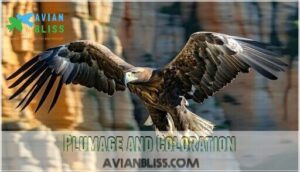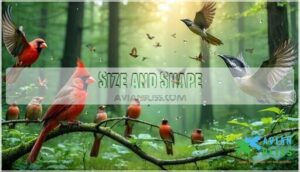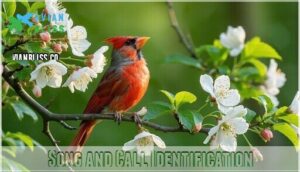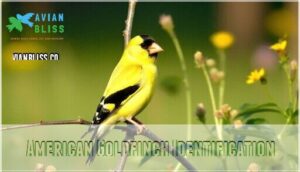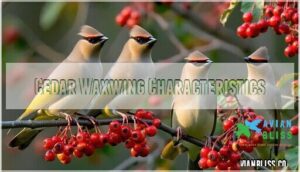This site is supported by our readers. We may earn a commission, at no cost to you, if you purchase through links.
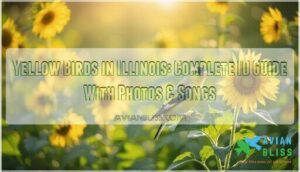 If you’re looking for yellow birds in Illinois, start with the American Goldfinch, the state’s year-round, sunshine-colored resident.
If you’re looking for yellow birds in Illinois, start with the American Goldfinch, the state’s year-round, sunshine-colored resident.
Its bright-yellow feathers and cheerful calls make it a backyard favorite, especially near feeders with nyjer or sunflower seeds.
In summer, keep an eye out for the Prothonotary Warbler in wetlands—it’s rare but worth the search for its golden plumage.
Other visitors include the Cedar Waxwing and even the Yellow Warbler, adding splashes of yellow across forests, parks, and gardens.
Each species has unique songs and behaviors, so grab binoculars, head outside, and see who’s singing near you, and if you Want more tips, Keep exploring!
Table Of Contents
- Key Takeaways
- Yellow Birds Overview
- Identifying Yellow Birds
- Year-Round Yellow Birds
- Seasonal Yellow Birds
- Attracting and Conserving
- Frequently Asked Questions (FAQs)
- What is a yellow bird in Illinois?
- How do I identify yellow birds in Illinois?
- What birds live in Illinois?
- Are there yellow headed blackbirds in Illinois?
- When are yellow warblers spotted in Illinois?
- Are yellow birds hard to spot?
- What kind of bird is bright yellow in Illinois?
- What is the difference between a yellow warbler and a goldfinch?
- What is the most common yellow bird?
- What is the yellow bird that looks like a goldfinch?
- Conclusion
Key Takeaways
- You’ll find year-round residents like American goldfinches and cedar waxwings, while seasonal visitors include yellow warblers and orioles.
- Check distinct habitats like fields, forests, and wetlands to spot yellow birds, as species prefer specific environments.
- Identifying yellow birds is easier by focusing on unique traits like plumage, size, habitat, and calls.
- Attract yellow birds to your yard using nyjer and sunflower seeds, native plants, and clean bird baths.
Yellow Birds Overview
You’ll encounter 14 notable yellow bird species throughout Illinois, ranging from year-round residents like the American goldfinch to seasonal migrants such as warblers and orioles.
Discover 14 vibrant yellow birds in Illinois, from resident American goldfinches to seasonal warblers and orioles, brightening diverse landscapes year-round.
These birds inhabit diverse environments including fields, forests, wetlands, and suburban areas, with some species present all year while others visit only during specific breeding or migration periods.
Types of Yellow Birds in Illinois
Illinois hosts fourteen distinct yellow birds Illinois species across multiple bird families.
You’ll encounter Warbler Varieties like yellow warblers and prothonotary warblers, Oriole Species including Baltimore orioles, and Tanager Differences between summer and scarlet tanagers.
Finch Distinctions help separate American goldfinch from evening grosbeaks, while Meadowlark Types include both eastern and western species.
These Illinois birds yellow represent diverse ecological niches throughout the state, including ecological niches and featuring summer tanagers.
Year-Round Residents and Migrants
Year-round yellow birds Illinois residents like American goldfinches showcase remarkable resident adaptations, staying through harsh winters by switching to seed-heavy diets.
Meanwhile, migration patterns bring yellow warblers during breeding seasons from April through September.
These migrant challenges include finding suitable winter habitats farther south, while Illinois birds yellow plumage helps attract mates during peak breeding periods, showcasing their ability to adapt and thrive in various environments with remarkable resident adaptations.
Habitat and Distribution
You’ll find yellow birds Illinois across remarkably diverse environments throughout the state.
These Illinois birds adapt to various habitats, from dense forests to bustling cities. Understanding yellow birds habitat helps you locate specific species more effectively during your birding adventures.
- Forest Habitats: Warblers and tanagers prefer wooded areas with thick canopy cover
- Wetland Distribution: Marshes and swamps attract yellowthroats and prothonotary warblers
- Urban Habitats: Goldfinches and orioles thrive in suburban parks and backyard gardens
To spot these birds, familiarize yourself with yellow bird identification.
Identifying Yellow Birds
When you spot a yellow bird in Illinois, you’ll need to examine specific characteristics like plumage patterns, body size, and behavior to make an accurate identification.
You can distinguish between species by noting details such as wing markings, tail length, beak shape, and the bird’s preferred habitat and feeding patterns.
Plumage and Coloration
When examining yellow birds Illinois, you’ll notice plumage variation changes dramatically throughout the year.
Seasonal molting transforms bright breeding colors into duller winter tones.
Color pigments like carotenoids create vivid yellows, while some species display iridescent feathers that shimmer in sunlight.
Juvenile plumage often differs substantially from adults, making bird coloration identification tricky for identifying yellow birds.
Many birders find identifying yellow birds particularly challenging.
Size and Shape
Bird watchers know that size matters when identifying yellow birds Illinois offers.
American goldfinch dimensions span 4.3-5.1 inches with compact builds, while meadowlark size reaches 8.5-11 inches with robust frames.
Warbler proportions stay petite at 4-5 inches, contrasting with oriole body lengths of 6.7-7.5 inches.
Tanager build measures 6.3-6.7 inches.
These measurements help distinguish species during Illinois yellow birds identification efforts, which is crucial for successful bird watching.
Habitat and Behavior
Where you spot yellow birds Illinois reveals their lifestyle secrets.
Bird habitats in Illinois shape distinct bird behavior patterns – goldfinches prefer open fields with seed sources, while warblers stick to dense woodlands.
Illinois bird species show unique nesting preferences, from cedar waxwings building in fruit trees to common yellowthroats choosing marshy ground cover.
Migration patterns and social behavior vary dramatically across bird habitats, influenced by the migration patterns.
Song and Call Identification
Since yellow birds share similar appearances, their unique vocalization patterns become your best identification tool.
Unique vocalizations act as nature’s audio fingerprints, helping birders identify yellow bird species where appearances can often deceive.
Each Illinois bird species produces distinct song complexity levels and call variations that act like audio fingerprints.
Some species display mimicry abilities or regional dialects that vary across locations.
Recording bird songs and calls with smartphone apps helps you compare sounds later, making bird identification of Illinois bird species much more accurate and reliable.
Year-Round Yellow Birds
You’ll find two primary yellow bird species that stay in Illinois throughout the entire year: the American goldfinch and the cedar waxwing.
These year-round residents provide consistent opportunities for identification practice, as they remain active in your local area during both summer breeding seasons and winter months.
American Goldfinch Identification
You’ll recognize the American goldfinch by its distinctive yellow and black plumage during breeding season.
Males display brilliant yellow bodies with black wings, tails, and caps, while females show duller olive-yellow coloring.
During molting plumage changes in fall, both sexes become brownish-gray.
Juvenile goldfinches resemble non-breeding adults, and you can watch for their undulating flight pattern and cheerful "po-ta-to-chip" call throughout Illinois.
Cedar Waxwing Characteristics
Cedar Waxwings stand out among Illinois yellow birds with their distinctive bandit mask and silky plumage.
You’ll recognize their unique waxy wings immediately.
These social birds exhibit fascinating behaviors:
- Plumage Details: Sleek brown-gray bodies with bright yellow tail bands
- Diet Preferences: Fruit specialists that swallow berries whole
- Social Behavior: Travel in flocks year-round, sharing food cooperatively
These birds are named for the waxy red tips on their wings.
American Goldfinch Habitat and Diet
The American goldfinch thrives in open woodlands, meadows, and near backyard feeders.
In Illinois, this vibrant bird species has a seasonal diet, favoring seeds such as thistle and sunflowers.
Goldfinches are adept at nesting in shrubs, using plant fibers and spider silk. Their seed preferences make them common visitors, adapting well to bird feeding efforts in suburban and rural areas, which is a key factor in their ability to thrive.
Attracting American Goldfinches to Your Yard
To attract American goldfinches to your yard, focus on backyard birdwatching essentials.
Use bird feeders filled with nyjer and sunflower seeds, their seed preferences. Provide fresh water sources like bird baths and nesting habitats with native plants and shrubs.
Protect them from predators by placing feeders strategically. Consider using specialized seed feeders for finches to prevent seed waste.
Enjoy watching these vibrant yellow birds brighten your space, a goldfinch Illinois treasure, and appreciate the beauty of native plants and the importance of fresh water sources.
Seasonal Yellow Birds
Seasonal yellow birds in Illinois bring a dynamic mix of species, with some arriving only during warmer months and others appearing as temperatures drop.
These birds’ migrations, breeding habits, and plumage shifts are key to identifying when and where you’ll spot them, with complete concepts of their behavior being essential for understanding their patterns.
Summer Resident Yellow Birds
In summer, Illinois welcomes vibrant yellow warblers, lively orioles, and the common yellowthroat.
These yellow birds brighten breeding habitats, like forest edges and wetlands, during nesting season.
Warbler migration peaks as they hunt insects, a key food source, while orioles showcase unique behavior building hanging nests.
Yellow warblers in Illinois thrive where insects abound, offering soundtracks of cheerful, buzzing songs.
Winter Resident Yellow Birds
When winter arrives in Illinois, some yellow birds stick around, showcasing their cold adaptations.
The American goldfinch, with its muted plumage, and the cedar waxwing rely on strategic feeding strategies like seeking berries or seeds.
Rare yellow bird sightings, such as the evening grosbeak, add to Illinois bird diversity.
Providing shelter needs guarantees these winter birds thrive amid harsh conditions, utilizing effective strategies like seeking berries or seeds.
Migratory Yellow Birds in Illinois
During migration, yellow warblers in Illinois light up marshes, thickets, and gardens as they travel to breeding grounds.
Look for yellow bird sightings in late spring and fall.
Migratory yellow birds face threats like habitat loss and climate impact, making conservation efforts essential.
Understanding migration patterns helps protect species like the yellow warbler and American goldfinch.
Rare and Uncommon Yellow Birds
Rare yellow birds in Illinois add excitement to birdwatching, but spotting them isn’t always easy.
Species like the yellow rail and yellow-headed blackbird require patience and keen observation. Conservation efforts help protect their habitats, ensuring future encounters.
These rare gems highlight the magic of regional birding. The Yellow-rumped Warbler, known for its distinct yellow patch, is another species to watch for.
- Yellow Rail: Elusive in wetlands.
- Yellow-headed Blackbird: Southern Illinois sightings.
- Prothonotary Warbler: Thrives near water.
- Evening Grosbeak: Winter rarity.
- Yellow Warbler: Migrant challenges.
Attracting and Conserving
You can attract yellow birds to your yard by offering nyjer seed, sunflower seeds, and providing native plants for shelter and food.
Ensuring access to clean bird baths and minimizing habitat disturbances helps support their conservation in Illinois.
Nyjer Seed and Sunflower Seeds
Nyjer seed and sunflower seeds are top picks for attracting yellow birds in Illinois like the American goldfinch.
Choose feeders with proper seed mix ratios and adjust for seasonal seed changes. Place feeding stations near shrubs or trees for safety.
Sunflower seed types, such as black-oil, are versatile, while Nyjer seed preference suits fin. Many bird enthusiasts find specialized feeders essential for these seeds, which are perfect for attracting American goldfinch with Nyjer seed.
Native Plants and Vegetation
Native plantings are a game-changer for attracting yellow birds in Illinois, like the American goldfinch or yellow warbler.
Restoring habitats and managing vegetation provides ecosystem benefits.
Consider these plants:
- Purple coneflower for seeds.
- Sunflowers for vibrant blooms.
- Milkweed for habitat restoration.
- Oak trees for shelter and insects.
- Elderberry shrubs for fruit.
These enrich birdwatching locations in Illinois!
Bird Feeders and Bird Baths
To attract yellow birds, place bird feeders in quiet, open areas near shrubs for bird safety.
Use feeder types that offer nyjer seeds or sunflower seeds.
Maintain bird baths regularly; a clean water source is essential for hydration and bathing.
Consider using specialized yellow feeders to attract more yellow birds.
Birdwatching improves with proper feeder placement and bath maintenance, turning your yard into a hub for bird conservation.
Conservation Status of Yellow Birds in Illinois
Conservation efforts are essential to protect yellow birds in Illinois as habitat loss, climate change, and pesticide impact threaten bird populations.
Population trends show declining numbers, pushing for stronger bird conservation strategies.
To further enhance their habitat, consider native plants and trees for natural food sources.
Support their survival by:
- Preserving wetlands and prairies they call home.
- Planting native trees and shrubs for shelter.
- Avoiding harmful chemicals that disrupt ecosystems.
Frequently Asked Questions (FAQs)
What is a yellow bird in Illinois?
A yellow bird in Illinois could be species like the American goldfinch or yellow warbler.
These stunning birds, often bright and lively, inhabit areas like fields, forests, or wetlands, adding charm to their environment, with complete concepts of their habitat being crucial to their survival.
How do I identify yellow birds in Illinois?
Ever wonder how to spot yellow birds in Illinois?
Focus on key traits like bright yellow plumage, markings, and size.
Use a field guide, binoculars, or even backyard feeders to identify these cheerful beauties.
What birds live in Illinois?
Illinois is a haven for diverse birds, from robins and cardinals to blue jays and warblers.
You’ll find them in woodlands, wetlands, parks, and backyards, each with unique songs, colors, and behaviors to enjoy.
Are there yellow headed blackbirds in Illinois?
Around 10% of Illinois bird checklists include the yellow-headed blackbird during migration.
You’ll often spot these striking birds in marshy areas, where their bold yellow heads and black bodies stand out beautifully.
When are yellow warblers spotted in Illinois?
You’ll typically spot yellow warblers in Illinois during spring and summer, particularly from mid-April to late September.
They favor bushes, streams, and gardens, especially during the breeding season, adding a bright splash to these areas.
Are yellow birds hard to spot?
Yellow birds aren’t too hard to spot if you know where to look.
Focus on open fields, woodlands, or wetlands.
Use a field guide, binoculars, and patience—they’re small but their bright plumage stands out.
What kind of bird is bright yellow in Illinois?
Picture a golden flash darting through trees—it’s likely an American goldfinch, Illinois’ state bird.
Males sport bright yellow plumage in summer, making them hard to miss as they perch near feeders or thistle plants.
What is the difference between a yellow warbler and a goldfinch?
A goldfinch is smaller, with a bright yellow body and black wings, while a yellow warbler is slightly larger, entirely yellow, often with reddish chest streaks.
Both are stunning, but goldfinches prefer seeds.
What is the most common yellow bird?
It’s almost unfair how the American goldfinch steals the spotlight as the most common yellow bird.
With its bright yellow feathers and cheerful song, you’ll easily spot this Illinois state bird in fields or backyards.
What is the yellow bird that looks like a goldfinch?
You’re likely thinking of the female American goldfinch.
It’s less vivid than the bright-yellow male, with olive-yellow feathers.
Another possibility is the pine warbler, which shares a similar yellow-green appearance.
Conclusion
As the saying goes, "The early bird catches the worm," so don’t miss the chance to spot yellow birds in Illinois.
From the bright American Goldfinch to the elusive Prothonotary Warbler, Illinois offers diverse habitats for birdwatching year-round.
Use your binoculars and tune in to their unique songs, aided by native plants and the right feeders.
With detailed observation and care, you’ll enjoy their vibrant colors and lively behaviors while contributing to their conservation.
Happy birdwatching!
- https://dnr.illinois.gov/education/wildaboutpages/wildaboutbirds/wildaboutbirdswaxwings/wabamericangoldfinch.html
- https://www.animalspot.net/yellow-birds-in-illinois
- https://www.audubon.org/field-guide/bird/yellow-warbler
- https://www.allaboutbirds.org/guide/Yellow_Warbler/id
- https://www.birdsandblooms.com/birding/bird-photography/small-yellow-birds

